Most workout plans tell you to train five or six days a week. That’s fine if you have the time, but most people don’t.
Between work, family, and everything else, it’s tough to fit long gym weeks into real life.
That’s where a full body workout plan comes in. You hit all major muscles in one session, three times a week.
That means fewer gym days, more rest, and steady results you can actually stick with.
In this blog post, you’ll get a full breakdown of a 3-day full body workout plan that builds strength and muscle without taking over your schedule.
You’ll see the exact exercises, how many reps to do, and how to keep making progress week after week.
Why Pick a Full-Body Workout Plan?
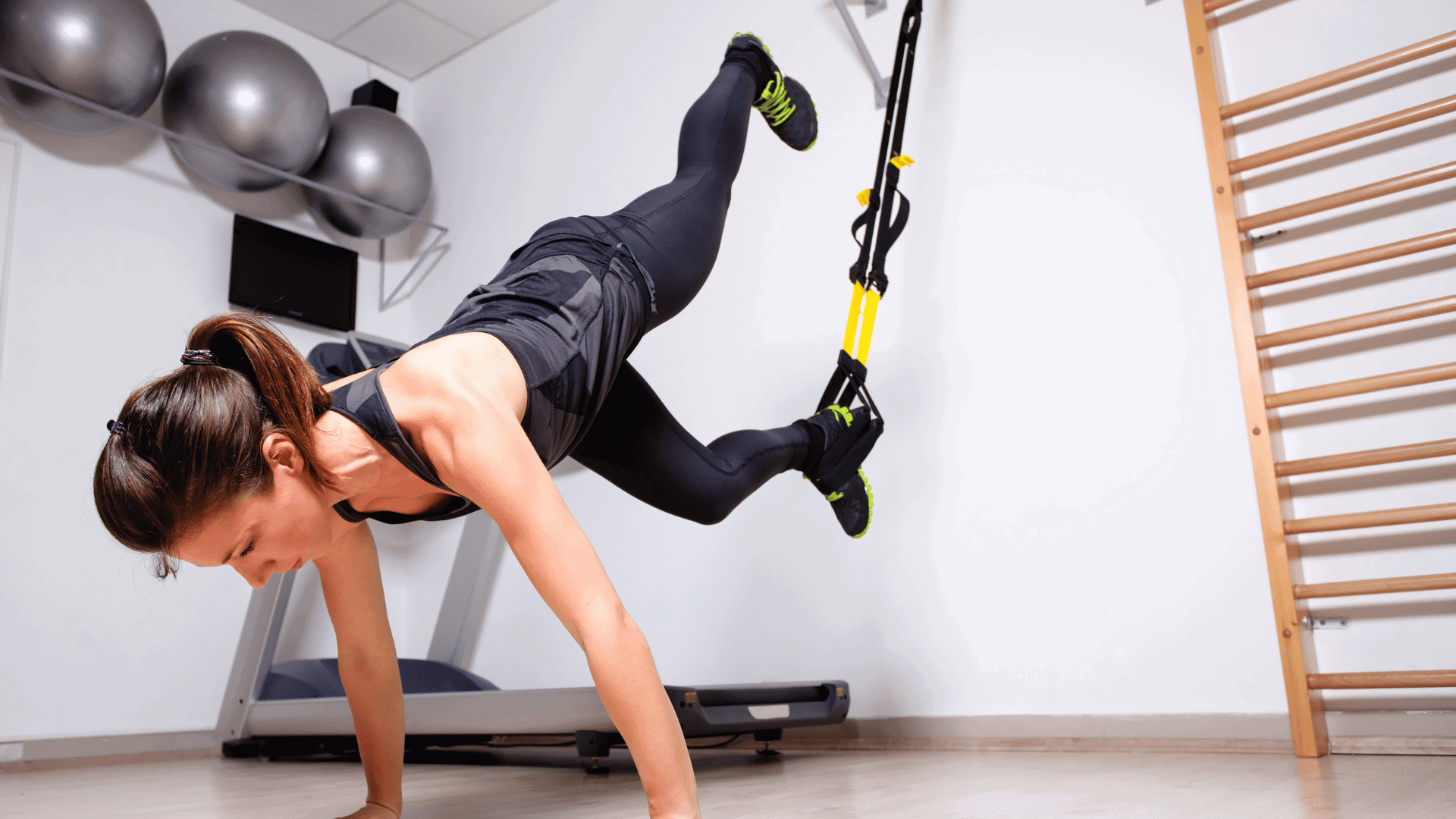
Most folks split their training—legs one day, chest another, and so on. That works, but it spreads your effort across the whole week.
A full-body plan is different. You train your upper and lower body in every session. That means fewer gym days, but more work done each time.
This setup is great for beginners and anyone short on time. Training more muscles in one session leads to faster strength gains, especially if you’re new to lifting.
You also repeat key movements more often, which helps you improve them quicker.
Each workout combines big lifts (like squats, presses, and rows) with smaller isolation moves. The big lifts build your strength. The smaller ones help round out weak spots and improve balance.
And since you’re only lifting three times a week, your body gets more time to rest and grow. You recover better. You stay consistent. And you’re more likely to keep showing up.
Your 3-Day Full Body Workout Plan
This full body workout plan keeps things simple. You’ll train three times a week (usually Monday, Wednesday, and Friday)
And each workout hits every major muscle group using a mix of heavy compound lifts and lighter isolation moves. On your off days, you’ll rest or do light movement to help your body recover.
Here’s how your week looks:
| Day | Workout | Key Lifts |
| Mon | Workout A | Bench, Lat Pulldown, Squat, Shoulder Press, Arms |
| Wed | Workout B | Incline DB Press, Cable Row, Leg Press, RDL, Lateral Raise |
| Fri | Workout C | DB Fly, Pull-Up, Lunges, Leg Curl, Overhead Press, Arms |
| Tue/Thu/Sat/Sun | Rest | Light cardio or stretching |
Workout A — Full Body Strength + Arm Work

- Barbell Bench Press – Lie on a flat bench with your eyes under the bar. Grip the bar a little wider than your shoulders. Lower it to your chest, then push it back up. Keep your feet flat on the ground the whole time. (3 sets × 5–8 reps)
- Reverse-Grip Lat Pulldown – Sit at the machine and grab the bar with your palms facing you. Pull it down toward your chest, squeeze your shoulder blades, then let it rise with control. (3 sets × 10–15 reps)
- Barbell Back Squat – Stand with the bar across your upper back. Feet shoulder-width apart. Bend your knees and hips to lower yourself until your thighs are level with the floor. Push through your heels to stand back up. (3 sets × 5–8 reps)
- Lying Leg Curl – Lie face down on the leg curl machine. Hook your heels under the pad and curl it toward your glutes. Lower it slowly back down. (3 sets × 10–15 reps)
- Dumbbell Shoulder Press
Sit or stand with a dumbbell in each hand at shoulder height. Press the weights overhead until your arms are straight. Lower with control. (2 sets × 5–8 reps) - Incline Dumbbell Curl
Sit back on an incline bench holding dumbbells at your sides. Curl them up while keeping your upper arms still. Lower them slowly. (2 sets × 10–15 reps) - Triceps Pressdown – Stand at a cable machine and grip the bar or rope. Push it down until your arms are straight, then bring it back up to chest height. (2 sets × 10–15 reps)
Workout B — Moderate Volume + More Leg Focus
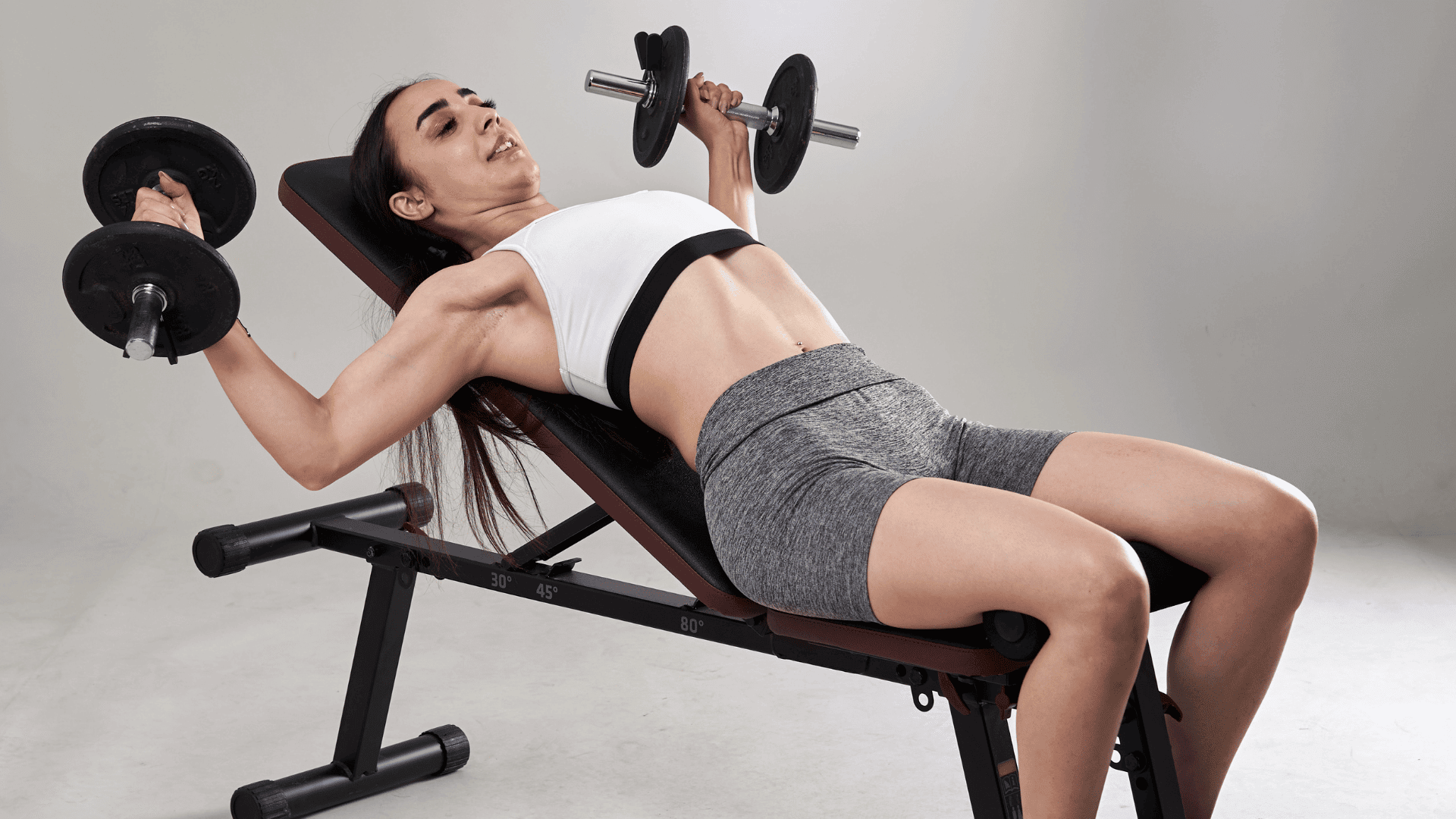
- Incline Dumbbell Press – Lie back on a bench set at a slight incline. Hold dumbbells at chest level and press them up until your arms are straight. Lower slowly. (3 sets × 10–15 reps)
- Seated Cable Row – Sit down and grab the handle. Keep your back straight as you pull the handle to your belly. Squeeze your shoulder blades, then return to the start. (3 sets × 8–12 reps)
- Leg Press Machine – Sit in the machine with your feet flat on the platform. Push the weight up, then lower it until your knees are bent about 90 degrees. Push back up. (3 sets × 10–15 reps)
- Romanian Deadlift (RDL) – Hold a barbell or dumbbells in front of your thighs. Keep your back flat and knees slightly bent as you lower the weight down your legs. Stop when you feel a stretch in your hamstrings, then stand up. (3 sets × 10–15 reps)
- Dumbbell Lateral Raise – Stand tall with dumbbells at your sides. Raise them out to shoulder height with straight arms. Pause at the top, then lower slowly. (2 sets × 15–20 reps)
- Calf Raises + Core (Optional) – Stand or sit and push through your toes to lift your heels. For core, add planks or crunches as needed. (2–3 sets each × 15–20 reps)
Workout C — Isolation Focus + Upper-Body Variety
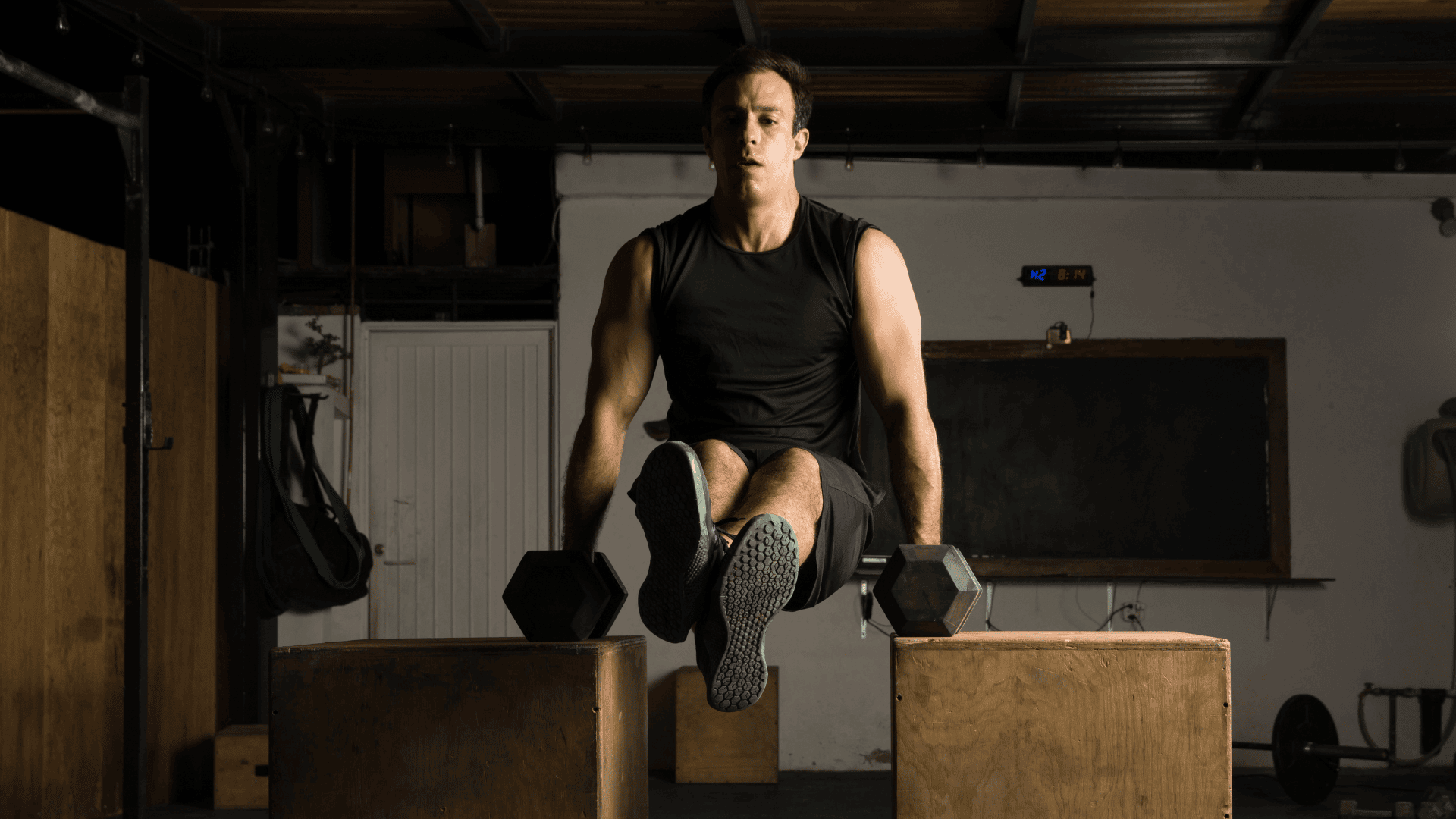
- Flat Dumbbell Fly – Lie on a flat bench with dumbbells above your chest. Lower them out wide with a slight bend in your elbows, then bring them back together at the top. (3 sets × 8–12 reps)
- Pull-Ups or Assisted Pull-Ups – Grab a pull-up bar with your palms facing away. Pull yourself up until your chin is over the bar. Use an assist machine or band if needed. (3 sets × 8–12 reps)
- Walking Lunges – Hold dumbbells at your sides and step forward into a lunge. Push back up and step forward with the other leg. Keep your chest up. (3 sets × 8–12 reps per leg)
- Lying Leg Curl – Same as in Workout A. Curl the pad toward your glutes, then lower it slowly. (3 sets × 10–15 reps)
- Barbell Overhead Press – Stand tall with a barbell at shoulder height. Push it overhead until your arms are straight. Lower it back down under control. (3 sets × 8–12 reps)
- Dumbbell Curl + Triceps Dips – For curls, lift the dumbbells up toward your shoulders with control. For dips, lower your body on parallel bars or a bench and push back up. (2 sets × 10–15 reps each)
Rest Days Matter Too

On Tuesday, Thursday, and weekends, take time to recover. Go for a walk, do some stretching, or use a foam roller. You don’t need to be in the gym every day to see progress.
Rest helps your muscles grow and your joints stay healthy.
How to Keep Progress Rolling with a Full Body Plan
This plan works best when you train with effort and keep track of your lifts. The goal isn’t to rush through sets or add weight every session. It’s to push with good form and stay consistent week after week.
Once you’re able to hit the top number in the rep range for every set of a lift, it’s time to bump up the weight slightly.
For the heavier compound moves, aim to work at about 75% of your one-rep max. That means the last rep should feel tough, but still doable with clean form.
For higher-rep work, choose a weight that challenges you without forcing sloppy reps. Keep your focus, control the tempo, and don’t rush.
After about six weeks, take a deload week. This helps your body recover and keeps you from burning out. Just cut your weight and volume in half for a few sessions, then get back to full training.
Stick with your main exercises as long as they’re working. Only swap them out if you’re stalled or need a break.
Progress doesn’t require constant change, it requires showing up and getting a little better each time.
Fueling the Gains

Lifting builds the demand. While food supports the growth. If your goal is to gain muscle and strength, what you eat matters just as much as how you train.
Focus first on protein. Your body needs it to repair and grow muscle after every workout. A good rule is to get between 0.8 and 1 gram of protein per pound of body weight.
A 180-pound guy should aim for around 145 to 180 grams a day. That’s easier to hit when you include some protein in each meal—like meat, fish, eggs, or a shake.
Next, add carbs. These give your body the fuel it needs to lift heavy and recover well. You don’t need anything fancy. Regular foods like rice, fruit, oats, and potatoes work great.
Healthy fats also play a role. They help keep your hormones in check. Include small amounts of things like avocado, olive oil, or nut butter.
If you’re busy, plan ahead. Cook a few meals in advance so you’re not scrambling during the week.
And don’t forget to hydrate. Half a gallon of water per day is the minimum target—more if you’re sweating often or training in heat.
What to Do When Equipment Isn’t Available
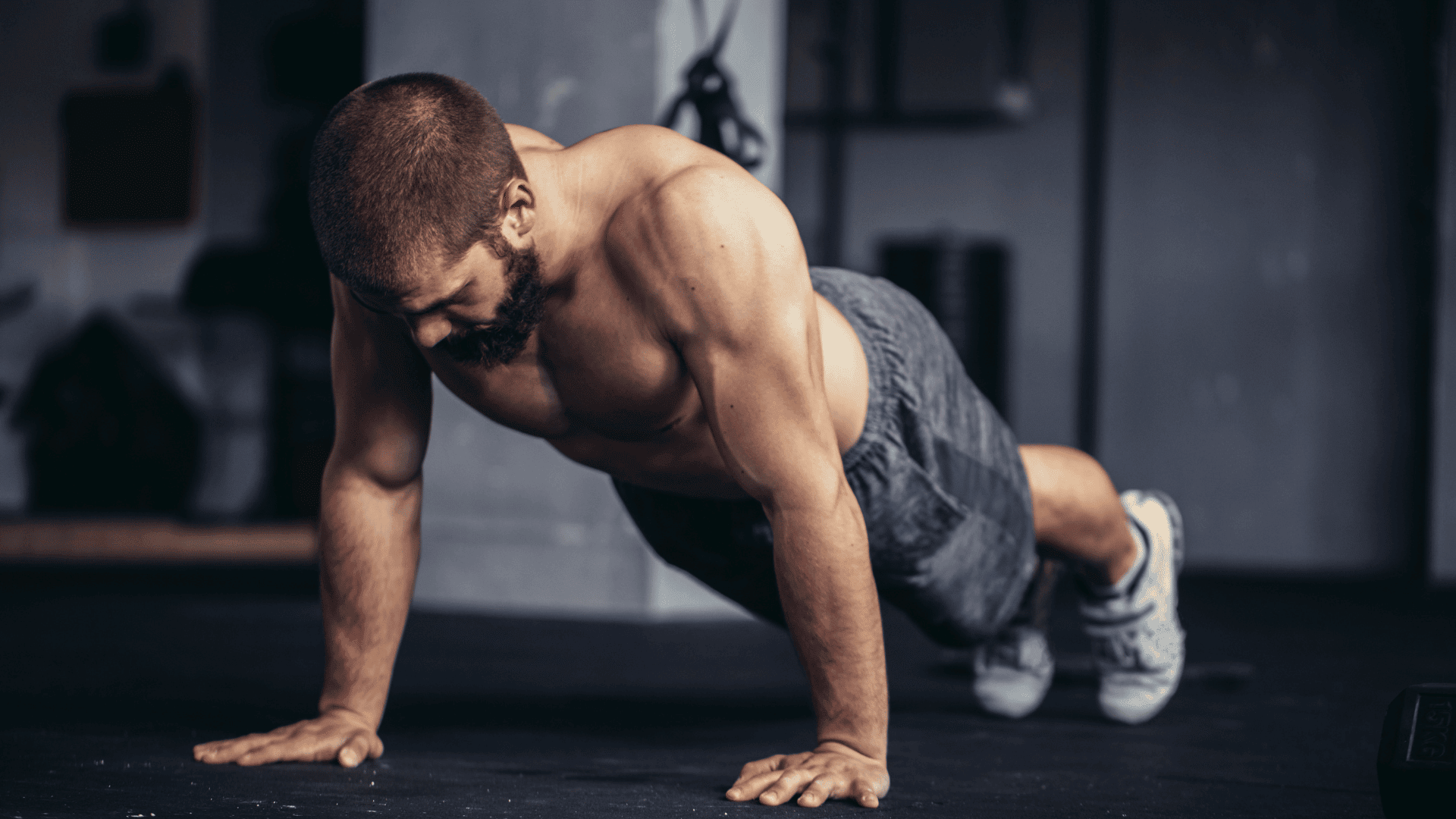
Not every gym day goes as planned. Sometimes machines are taken, or you’re working out at home with limited gear. That doesn’t mean you need to skip your session.
Bodyweight exercises can still train the same muscles if you push with enough reps and control.
Try push-ups instead of bench press, step-ups or wall sits instead of squats, and slow bodyweight rows using a towel or a low bar.
At home, use what you already have. A loaded backpack works well for squats, lunges, or bent-over rows. A resistance band can handle curls, triceps work, and shoulder raises.
The key is to match the movement pattern, not the exact tool. As long as the effort is there, the muscles will grow.
Are You Ready to Start This Full Body Workout Plan?
Long, complicated workout routines aren’t the only way to build muscle. With the right structure, you can train your whole body, make steady progress, and still have room for everything else in your life.
This 3-day full body workout plan covers every muscle, keeps your schedule clear, and gives you the structure to move forward.
If you’ve struggled to stay consistent before, this plan makes it easier to show up. You’ll know exactly what to train and how to do it.
Pick a start date. Log your workouts. Focus on one week at a time.
It won’t all happen overnight. But if you stick with it, your body will change and so will your mindset. You’re not just training to look better.
You’re showing yourself what you’re capable of.
Unlock Your Best Full Body Results
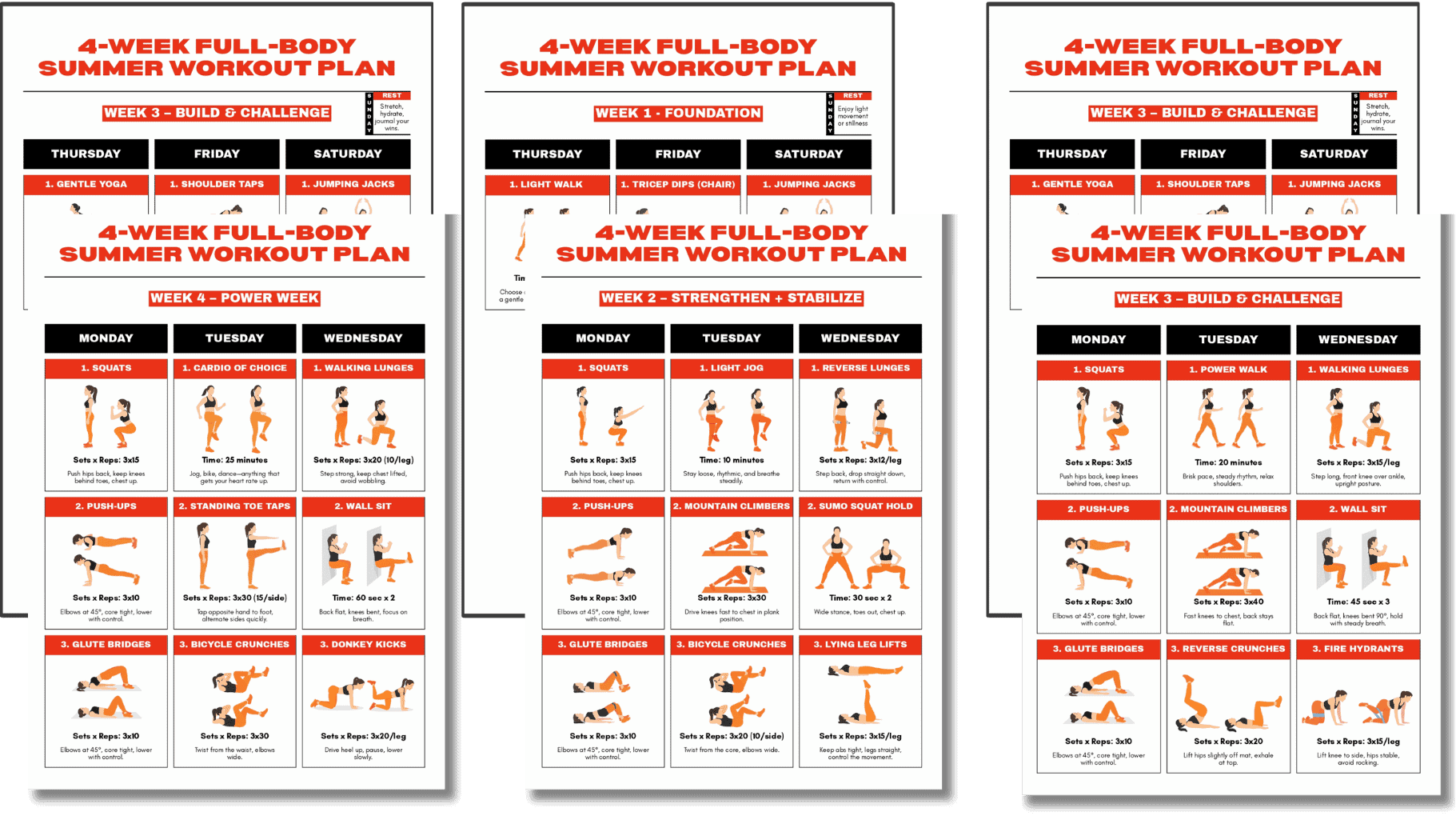
A workout plan only works if you can stick with it week after week.
This 3-day full body routine shows you how to train smart, but pairing it with a structured guide makes consistency even easier.
That’s where the Free 4-Week Full Body Summer Workout Plan comes in.
It gives you a ready-to-follow schedule that balances strength, recovery, and energy, so you’re not left wondering what to do next or second-guessing your progress.
Instead, you’ll have a clear path to keep moving forward and see steady results you can feel by the end of the month.
FAQs
1. Can I do this workout plan if I’ve never lifted weights before?
Yes. This plan works well for beginners. The exercises are simple, and the structure is easy to follow. Start with light weights, move with control, and take your time learning each lift. You don’t need to be perfect—you just need to show up and do your best.
2. What if I only have two days to train this week?
It’s fine. Life happens. Just pick two of the workouts and spread them out. The next week, continue with the one you missed. As long as you’re consistent over time, you’ll still make progress.
3. Should I warm up before each workout?
Yes, always. Warming up helps your body move better and lowers your risk of injury. Walk for 5 to 10 minutes to get your heart rate up, then do a lighter set or two of your first lift before going into full sets.
4. Do I need to train to failure on every set?
No. You don’t need to max out every time. Leave one or two good reps in the tank, especially on your first few sets. That helps you stay fresh, move well, and recover faster.
5. How do I know when to increase the weight?
If you’re hitting the top number in the rep range on every set, and it still feels strong and steady, it’s time to go up. Add a small amount of weight—just enough to keep it challenging without losing form.










